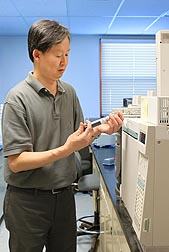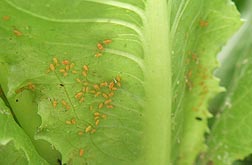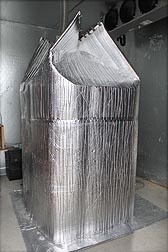Oxygenated Phosphine Fumigation for
Pest Control on Harvested Fruits and Vegetables
Shipments of U.S. fresh fruits and vegetables can face obstacles in export to overseas markets if they harbor unwanted pests. There are few workable options to kill the pests, and methyl bromide fumigation is the most common one. But methyl bromide destroys atmospheric ozone, and its production is being phased out globally. Therefore, methyl bromide fumigation is unsustainable—as well as expensive. In addition, methyl bromide fumigation injures some fresh produce, such as lettuce. Scientists are searching for alternative ways to solve postharvest pest problems on exported fresh products.
Entomologist Yong-Biao Liu, at the U.S. Agricultural Research Station in Salinas, California, is working on low-temperature fumigation with phosphine as an alternative to methyl bromide for control of pests on harvested fresh fruits and vegetables.
Phosphine has been used for more than 80 years as a fumigant to control stored-product pests. It acts slowly against insects. Many insects, especially at egg and pupal stages, are very tolerant of phosphine, and it may take more than 10 days of fumigation treatment to control them. In working on fumigation with pure phosphine at low temperatures, Liu found that oxygen enhances phosphine toxicity against insects. Liu calls the treatment “oxygenated phosphine fumigation.”
In a series of experiments, Liu tested phosphine fumigation under high levels of oxygen against four insects and at different life stages: western flower thrips adults and larvae, leafminer pupae, grape mealybug eggs, and Indianmeal moth eggs and pupae. Liu says that the four species represent a range of insect types and life stages for which quarantine treatments are needed.
|
|
“It is important to test the fumigation on eggs and pupae because, in general, eggs and pupae are more tolerant of phosphine than larvae and adults,” says Liu. “If we can control insects at the egg and immature stages, we can be sure adults will also be controlled. These insects eat, and thus damage, produce while they are in the larval stage, but all stages require quarantine treatment.”
The small-scale study demonstrated that in 5-hour fumigations with 1,000 ppm (parts per million) phosphine at 5°C, control of western flower thrips on lettuce increased from 80 percent to 98 percent when oxygen was increased from 21 percent to 40 percent. When the oxygen level was increased to 80 percent, mortality of western flower thrips reached 99 percent.
Western flower thrips are a common pest of fruits and vegetables in the United States and are often found on fresh products exported to Taiwan, where it is a quarantined pest. Currently, fresh fruits and vegetables exported to Taiwan are fumigated with methyl bromide to control western flower thrips.
Leafminer pupae control was also improved when oxygen was introduced: At normal oxygen levels, more than 70 percent survived, but only 16 percent were still alive at 40 percent oxygen, and just 1 percent survived at 80 percent oxygen. This fumigation treatment was conducted over 24 hours and contained 500 ppm of phosphine at 5°C. Complete control of leafminer pupae was achieved in a 24-hour fumigation with 1,000 ppm of phosphine at 5°C under 60 percent oxygen.
“Increased oxygen levels also resulted in significantly lower survival rates of Indianmeal moth pupae in response to 24-hour fumigations with 500 and 1,000 ppm phosphine at 10°C, and complete control was achieved at 1,000 ppm phosphine at 60 percent oxygen,” says Liu.
“Oxygen enhanced the phosphine toxicity significantly for all life stages tested. This has not been reported previously, and the findings have potential to be used to develop more effective phosphine fumigation treatments for pest control. The magnitude of toxicity enhancement will likely vary depending on the insect species and their life stage.”
In a follow-up study for control of lettuce aphid on lettuce, Liu demonstrated that oxygenated phosphine fumigation is not only more effective against the pest but also less toxic to plants than regular phosphine fumigation. At a low temperature of 3°C, regular phosphine fumigation took 3 days at more than 2,000 ppm concentration to control lettuce aphid, and the treatment resulted in significantly higher percentages of both romaine and head lettuce having injuries than the 2-day oxygenated phosphine fumigation at 1,000 ppm concentration under 60 percent oxygen, which also controlled lettuce aphid. Liu says that the shorter treatment combined with lower phosphine levels in oxygenated phosphine fumigation makes the treatment less phytotoxic than regular phosphine fumigation.
Fumigating under high oxygen is also safer to conduct than regular phosphine fumigation. Used alone, phosphine will burn in the air if its concentration exceeds 1.8 percent. Past research showed that oxygen will suppress phosphine ignition and thus reduce risk of fire. The shorter treatment time and lower phosphine concentration used in oxygenated phosphine fumigation also reduce fire risk. Liu says that this is particularly true for fresh products as they are fumigated under low temperature and high humidity conditions.
Even though oxygenated phosphine fumigation is more complex and expensive than regular phosphine fumigation, Liu is optimistic that its benefits in terms of reduced treatment time and enhanced ability to control tolerant pests will more than compensate for the added costs and complexity. Liu expects that the oxygenated phosphine fumigation he developed will have an impact on the phosphine fumigation industry, because many insects that cannot be controlled by regular phosphine fumigation in a reasonable time frame can now be controlled effectively with the new method.
The research studies described in this story were published between 2008 and 2012 in the Journal of Asia-Pacific Entomology and the Journal of Economic Entomology.—By Sharon Durham, Agricultural Research Service Information Staff.
This research is part of Crop Protection and Quarantine (#304) and Methyl Bromide Alternatives (#308), two ARS national programs described at www.nps.ars.usda.gov.
Yong-Biao Liu is in the USDA-ARS Crop Improvement and Protection Unit, U.S. Agricultural Research Station, 1636 E. Alisal St., Salinas, CA 93905; (831) 755-2825.
"Oxygenated Phosphine Fumigation for Pest Control on Harvested Fruits and Vegetables" was published in the July 2012 issue of Agricultural Research magazine.










